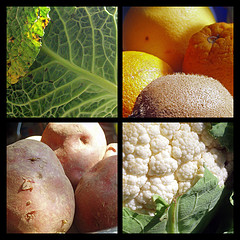
 There’s no doubt about it-organic is catching on. This is good news for most of us who have been seeking out products made with safer ingredients, or foods with fewer pesticides. However, the market is still growing, and it can be confusing to determine exactly just what “organic” means when applied to produce, cosmetics, or even coffee. Here are a few guidelines to help you make your best choices.
There’s no doubt about it-organic is catching on. This is good news for most of us who have been seeking out products made with safer ingredients, or foods with fewer pesticides. However, the market is still growing, and it can be confusing to determine exactly just what “organic” means when applied to produce, cosmetics, or even coffee. Here are a few guidelines to help you make your best choices.
Produce: If you see the USDA Organic seal on produce, it means it was produced without most conventional pesticides or fertilizers made with synthetic ingredients or sewage sludge. Organic farmers also emphasize renewable resources and conservation of soil and water. On the whole, organic fruits and vegetables have less pesticide residue and lower nitrate levels than conventional fruits and vegetables.
Meat & Dairy: Organic means the livestock were not given antibiotics or growth hormones. A new regulation requires that the animals graze on open pastures for at least 120 days, and 30% of their dietary needs must come from pasture. Organic milk has more vitamins, antioxidants, and omega-3 fatty acids then regular milk. Organic meat also has higher levels of omega-3s and lower fat overall than that from animals fed a high-corn diet.
Cosmetics: Chemicals in personal-care products have been linked with cancer, asthma, hormone-disruption, skin irritation, and more. However, organic cosmetics are not as closely regulated as organic foods, so you have to be careful and read ingredient lists. Even those that have certified-organic seals-such as the USDA seal-do not provide a guarantee of safety for sensitive skin. Organic standards are not safety standards, but are more about promoting greenness and sustainability, while pushing organic agriculture. Learn what ingredients to avoid, and rely on the back of the label, not the front.
Processed: Believe it or not, processed foods are now coming in organic versions. We’re talking things like cookies, crackers, and pasta. These are regulated by the USDA, and if the product carries the seal, it must have at least 95% organic ingredients. Read the ingredient label-organic crackers and cookies often stay away from high fructose corn syrup, which we can all do without. The label on your baby food items may also give you peace of mind in that the product is low on pesticides. However, just because it says “organic” doesn’t mean it’s healthy-organic cookies may still have a lot of calories and sugar, for example, so consume sparingly!
Cotton and Coffee: Since these two crops are usually heavily covered in pesticides, organic brands have come to light. Most of the pesticides are removed during processing, but they can affect the land where the crops are grown. Buying organic can help preserve environmental health.
Do you buy more organic than you used to? Please share your thoughts.
Photo courtesy volatile1966 via Flickr.com.

